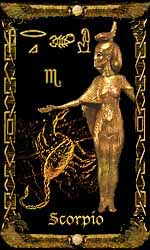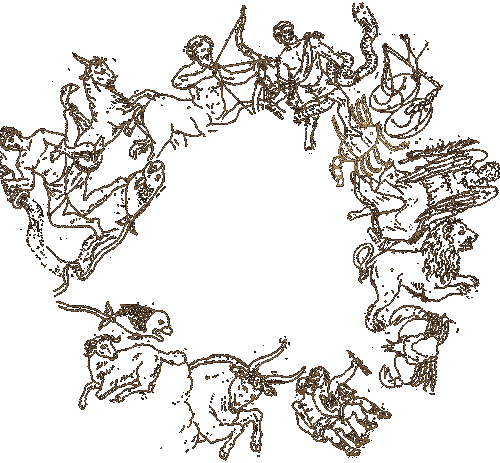




The constellation of Scorpio, located between Libra and Ophiuchus, is very
ancient, known to the earliest Mesopotamian civilisation in around 3000 BC,
receiving lots of attention especially for its bright shining star Antares.
![]() In ancient Egypt the scorpio was associated
to the scorpion goddess Serket (Selket, Serqet), whose name translated as 'She who
causes the throat to breath'. Serket was shown as a beautiful woman with a scorpion
on her head, or as a scorpion with a woman's head. Her scorpions could be deadly
little killers, but had their good tasks, as well. Legends tell that Serket sent
seven of them to protect Isis from Seth, and some others to fight the demons that
were threatening Ra.
In ancient Egypt the scorpio was associated
to the scorpion goddess Serket (Selket, Serqet), whose name translated as 'She who
causes the throat to breath'. Serket was shown as a beautiful woman with a scorpion
on her head, or as a scorpion with a woman's head. Her scorpions could be deadly
little killers, but had their good tasks, as well. Legends tell that Serket sent
seven of them to protect Isis from Seth, and some others to fight the demons that
were threatening Ra.
Having a reputation as both destroyer and helper, Serket was worshipped as the
helper of women in childbirth, and as a healer who cured the innocent that were
'accidently' bitten by scorpions. In early times she was viewed as a tutelary
goddess of the dead who protected the canopic jars that contained the viscera of the
deceased.

Like Isis, whose association with the constellation Virgo survived in her wings,
Serket's name left its traces in Scorpio. 'She who causes the throat to breath' - it
is amazing that even in our days the most common astrology takes the Scorpio as the
constellation which is responsible for throat and breathing.
Some early Egyptian records called the constellation a serpent, but the serpent soon
got its own images in the constellations Serpent and Ophiuchus. Ancient Babylonians
had the legend of the scorpion men who were the children of the dragon mother
Tiamat, deadly warriors on one side and sacred guardians of the sun on the other,
showing the same double meaning that Serket had later.
The Greek mythology connected Scorpio with the scorpion that was sent by Apollon to
kill the hunter Orion, who was told to be a very attractive guy and Apollon went
jealous seeing him hunting with his sister Artemis. The scorpion killed Orion and
Zeus placed them both in the sky.

